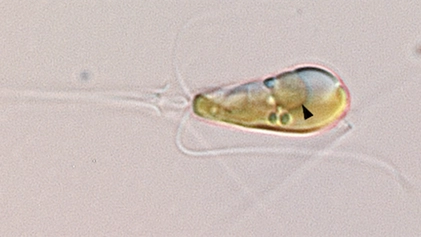Imagining algae, our mind might drift towards their seemingly simple, and often overlooked exterior, a green slimy sludge usually sitting atop lakes or ponds. Delving a bit deeper inside the simple creatures lies a marvelous world, among them is a tiny marvel known as the Nitroplast, the powerhouse of Nitrogen fixation in marine algae and perhaps something greater in the near future.
Black arrow: the nitroplast inside B. bigelowii
Previously thought of as a separate organism found in the marine algal protoplasm, “Candidatus Atelocyanobacterium thalassa” or “UCYN-A'', was discovered in 1998 by a marine ecologist, Jonathan Zehr, which is now a known endosymbiont of the unicellular marine algae Braarudosphaera bigelowii. It was thought that UCYN-A behaved like an organelle, taking nutrients, proteins, and even genetic code from its host cell, it sounds like a pretty lazy bacteria, doesn't it? But it’s really not. It does something that the algae can not, converting N2 into useful Ammonia. It wasn’t always like this though.
Almost a billion years ago, a new prokaryote came into town, which we now know as the chloroplast which allowed plants to thrive on Earth. A billion years before that came the strongest prokaryote of them all, the Mitochondria. Defeating every organelle and becoming the powerhouse of the cell, essentially allowing complex life to exist in this world. From this, we can discern that this is another instance in which prokaryotes depend on a cell and become an organelle through endosymbiosis, the process of two different life forms becoming one.
Researchers didn’t immediately call the cyanobacteria an organelle without testing other routes. Using X-ray tomography, researchers saw that the cyanobacteria, lacking nearly 2000 various proteins, and a lot of genetic code, have the inability to fix carbon nor the gene for RuBisCO, which is quite essential and something the bacteria depends on the host cell for. Another criterion for becoming an organelle is that they are inherited during cell division of the marine algae. The two key criteria for being an algae are that they import protein from the host cell and are inherited during cell division, which the Nitroplast fits perfectly.
Thus, in 2024, scientists have started referring to the Nitroplast as an organelle, opening up a new path for research and quite possibly, a way to improve every life on Earth by benefiting the environment through an approach we’ve always been searching for, given how widespread these algae are.
Discovering this organelle holds a lot of significance in our ecosystem, not just for humans but also for plants and almost every life on Earth. Assimilating N2 and converting it into productive forms such as Ammonia will lead to enormous changes in our environment. As of now, plant roots exist in a symbiotic relationship with some bacteria that help plants assimilate and convert Nitrogen to Ammonia which the plants can utilize.
Now imagine a plant that doesn't need to do all this, a GMO that can fix its own Nitrogen, and make its own Ammonia. Not only will this improve soil quality, reduce nitrogen emissions, and help improve crops but will also save us on resources in making fertilizers, helping in averting the devastating effects of desertification and improving the land quality for the next crop. This is one of the major implications that our scientists are speculating on. Perhaps with the increasing demand for food and resources, we might be able to keep up with it using human beings' greatest asset, our forebrain, and our indomitable spirit with a little extra help from our planet Earth.




Comments